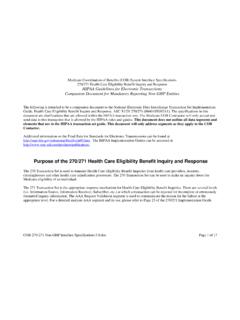Transcription of Bismarck vs. Beveridge: is there increasing convergence ...
1 Bismarck vs. Beveridge 21-22 November 2011 Bismarck vs. Beveridge: is there increasing convergence between health financing systems? Joseph Kutzin Coordinator, health Financing Policy, WHO 1st annual meeting of SBO network on health expenditure 21-22 November 2011 Paris, OECD Bismarck vs. Beveridge 21-22 November 2011 Outline health financing models and myths Public finance and health finance: some important policy interactions for sustaining good performance Summary messages Bismarck vs. Beveridge 21-22 November 2011 History, models and myths in health financing Bismarck vs. Beveridge 21-22 November 2011 Roots of government-mandated health insurance Bismarck and "Social health Insurance" (1883) Compulsory funding by employers and employees, administered by pre-existing "sickness funds" Similar laws in Japan (1922) and elsewhere in Europe A "right" associated with labor status Keep workers healthy to improve productivity Pre-empt labor unrest Was not aimed at "universal coverage" Bismarck vs.
2 Beveridge 21-22 November 2011 Post-WWII: towards Universal Coverage Beveridge: the National health Service (1948) Funded from general government revenues, coverage for entire population Funding base similar to that of USSR system, but providers much more independent More generally in high income countries (and then globally), a shift from health coverage as a right of labor, to " health as a human right" or health coverage as a constitutional or legal right Concern with universality, social cohesion/solidarity Stylized models Feature Bismarck Beveridge Entitlement basis Contribution Citizenship/ residence Funding base Wages All public revenues "Insurer" Occupational State Benefit package Explicit Implicit Management Independent Government Providers Privately contracted Salaried and publicly contracted Bismarck vs.
3 Beveridge 21-22 November 2011 Independent or "government"?? "Compulsory contributions" of employers and employees ( payroll taxes), are considered part of "fiscal space" SHI funds are treated as public entities Estonian health Insurance Fund was initially restricted by MOF from using its accumulated reserves because this would have made the fiscal deficit appear larger at a time when the country was trying to enter zone (was allowed later in that year and the next, enabling the Fund to benefit from its prudent management over time) Bismarck vs. Beveridge 21-22 November 2011 Freeing from historical Similarities in different models Purchaser-provider split in the UK and Germany, each using innovative methods to change the incentive environment Differences within the same model Single SHI insurer in Estonia, France, Hungary, Multiple competing SHI insurers in Germany, and also (including some commercial for-profit) in Czech Republic, Germany, Netherlands, Slovak Multiple non-competing SHI insurers in Japan health financing design questions to be addressed in different types of systems What are the sources of funds, and how are they collected?
4 How are funds pooled on behalf of the population? How are providers paid? How do funds flow through the system, and what are the associated institutional arrangements? What are the entitlements and obligations of the people? What is the basis for entitlement? What are the sources of funds, and how are they collected? How are funds pooled on behalf of the population? How are providers paid? How do funds flow through the system, and what are the associated institutional arrangements? What are the entitlements and obligations of the people? What is the basis for entitlement? Bismarck /SHI Beveridge/NHS So today's reality is more like this Feature Bismarck Beveridge Entitlement basis Contribution Citizenship/ residence Funding base Varies Varies "Insurer" Varies Varies Benefit package Varies Varies Management Varies Varies Providers Varies Varies As per the new System of health Accounts (OECD, WHO, Eurostat), the only difference between the "models" has to do with the nature of entitlement.
5 We observe variation along all the other dimensions. Bismarck vs. Beveridge 21-22 November 2011 Implications of shift from health as a labor right to a right of citizenship Since not everyone is employed in large firms, and contributions for some may not be affordable, the move to Universal Coverage in "SHI countries" required subsidies from general revenues Countries do this to varying degrees If not, they leave part of their population without entitlements ( Estonia) Growing recognition that "everyone contributes" in the sense that virtually everyone is paying VAT Bismarck vs. Beveridge 21-22 November 2011 More challenges for "pure Bismarck " model Demographic change/aging Smaller share of total population will be economically active Competitiveness and employment concerns International competition to attract firms and maintain/increase employment will put downward pressure on labor taxes How to sustain Universal Coverage in this context?
6 Expected demographic change in the Czech Republic Source: Presentation by Pavel Hrobo to Parliamentary seminar on health insurance reform in Hungary. Budapest, 2007. Can payroll contributions continue to account for at least 90% of Germany s SHI revenue? What options to avoid harmful impact on labor market and competitiveness? 10%15%20%25%30%35%40%2004200720102013201 620192022202520282031203420372040average contribution ratebasisscenario 1scenario 2 Source: Dirk Sauerland, WHL Graduate School of Business and Economics, presentation to 6th European Conference on health Economics, 6-9 July 2006, Budapest Bismarck vs. Beveridge 21-22 November 2011 Germany's response 2007 law increased budget transfers to the insurance funds After crisis in 2009, Government injected general revenues into health insurance system in order to reduce payroll tax rate by 1% due to concerns about unemployment (later reversed) This was just an adjustment of sources, but did not imply any fundamental change in the German health financing system Hungary also changed its funding sources in response to the crisis Sources of revenue for the health Insurance Fund in Hungary (WHO based on HIF data) *2011*yearsPercentage of total EmployerEmployeeGovernment budgetOther sourcesSource: Szabolcs Szigeti, WHO based on HIF data Towards the Bev-marck or Bis-eridge model?
7 convergence on sources Growing, explicit role for general revenues in SHI Some de-linkage of coverage from the labor market Irrespective of the source of funds, we observe variations and innovations across "models" in organization of pooling, mechanisms for purchasing of services, and ways that the entitlements and obligations of the population So labelling a system as Beveridge or Bismarck is not especially useful. But what are some important questions and issues of concern? Bismarck vs. Beveridge 21-22 November 2011 health finance and public finance: some important issues for sustaining performance 1. Crisis and the need for counter-cyclic fiscal policies for health expenditure Need for health care during the crisis increases, but public revenues decline If public spending on health falls, burden shifted to patients, who may either forego needed care or run greater risk of incurring potentially catastrophic spending Major cuts in public expenditure may result in disruption of continuity of care and deterioration of quality of care Bad combination: Utilization and quality of services and can decline despite increased needs Bismarck vs.
8 Beveridge 21-22 November 2011 Where policies protected people against the costs of seeking care, the reduction of utilization was lower Source: Lusardi et al. The economic crisis and medical care usage 2010. Harvard Business School Reductions in routine care today might lead to undetected illness tomorrow and reduced individual health and well-being in the more distant future. Counter-cyclical health financing policy in Canada: An example to follow -6%-4%-2%0%2%4%6%8%198019811982198319841 9851986198719881989199019911992199319941 9951996199719981999200020012002200320042 005200620072008 Annual Growth (%)Growth of real per capita GDPG rowth of real per capita THES ource: OECD health Data 2010 Source of slide: Tam s Evetovits Counter-cyclical health expenditure strategies requires sound fiscal policies Fiscal policy in countries with high public debt and high government deficits tends to be pro-cyclical, while countries that have low public debt and that have surpluses are more likely to conduct a counter-cyclical fiscal policy.
9 A possible Bev-Bis difference in modality, but not in aim: Sound policy on reserve accumulation in SHI funds (like Estonia) Sufficiently sound long run fiscal policy to enable counter-cyclical health (and perhaps other social welfare) spending (like Canada) Source: Prof. Angelmar, INSEAD based on B. Egert, Fiscal Policy Reaction to the Cycle in the OECD: Pro- or Counter-cyclical? OECD Economics Department Working Papers, No. 763, May 2010 2. How to deal with the sustainability tradeoffs in face of fiscal pressures Requirement for fiscal balance Explicit rationing Non-price (wait lists) access barriers, dissatisfaction Price (formal copays & service exclusions) access barriers, financial burden Implicit rationing Non-price (service dilution, delay, denial) less health gain, reduced access, dissatisfaction, lack of transparency Price (informal payments) access barriers, financial burden, lack of transparency Source.
10 Kutzin and Evetovits 2007 Improving efficiency (more health for the money) is essential to lessen severity of the tradeoffs eliminate ineffective and inappropriate services improve rational drug use (including volume control) allocate more to primary care and outpatient specialist care at the expense of hospitals invest in infrastructure that is less costly to run cut the volume of least cost-effective services Reduce unproductive administrative costs Bismarck vs. Beveridge 21-22 November 2011 Main health financing tool for this is strategic purchasing (pay for performance) Linking the allocation of resources to providers to measures of their performance and health needs of the population being served Changing the incentive environment through tailored use of markets and planning Strategic purchasing is happening in OECD countries (and elsewhere), irrespective of the label attached to the system Bismarck vs.
















